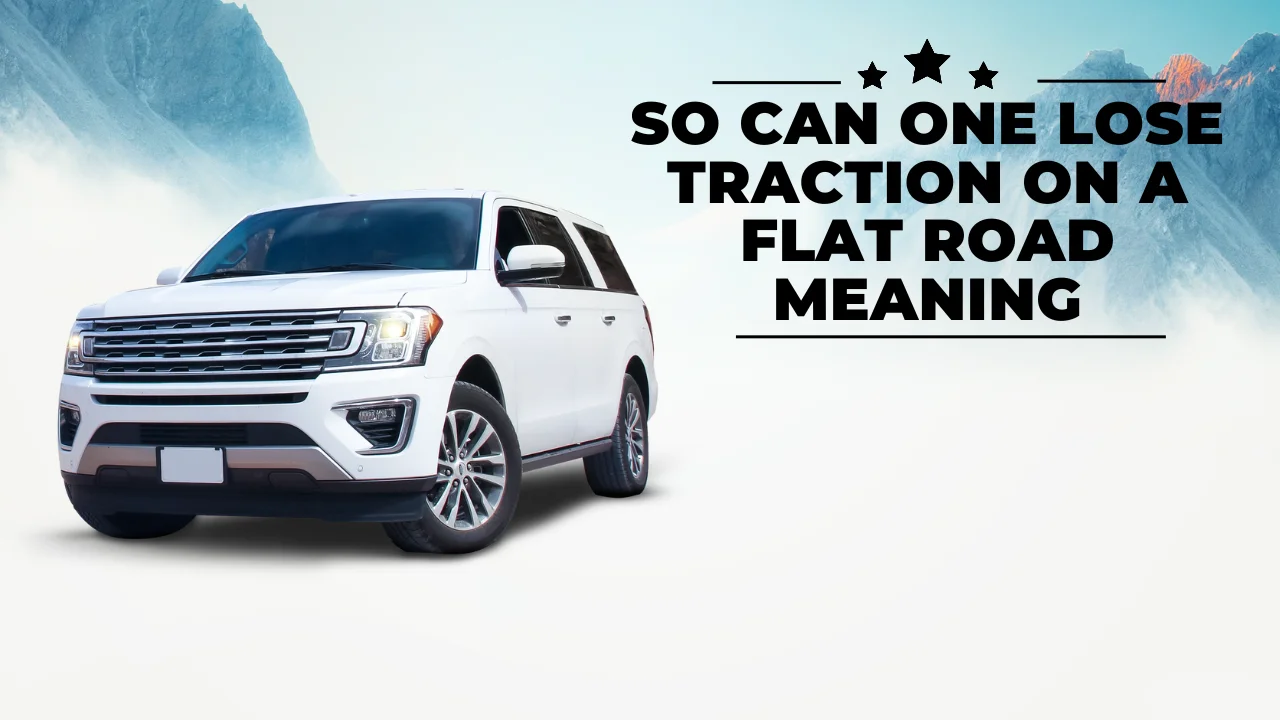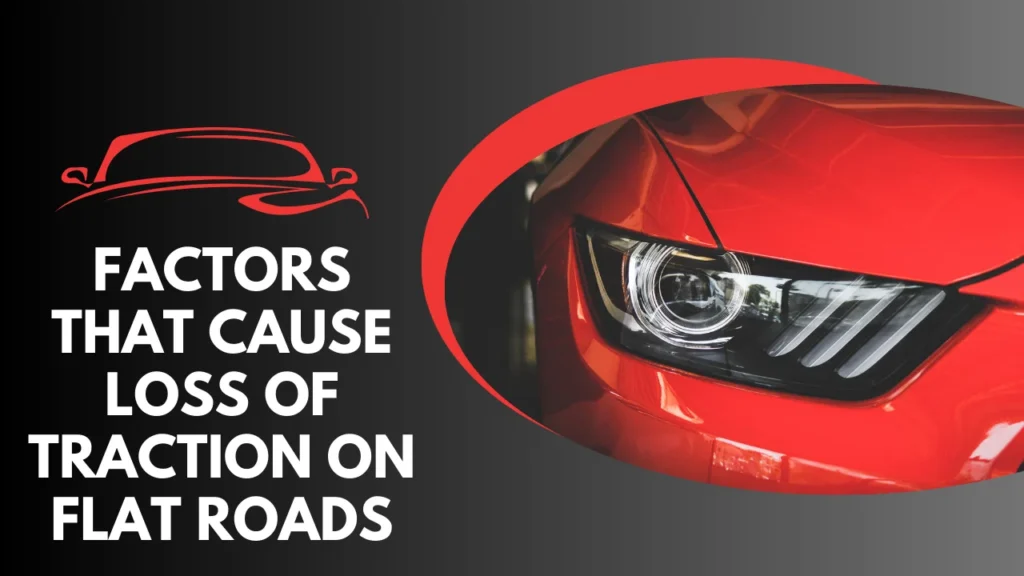So Can One Lose Traction on a Flat Road Meaning

When people hear the term “losing traction,” they often imagine slippery, icy roads or steep inclines. However, it’s entirely possible to lose traction even on a flat road. This concept is puzzling to many drivers, which brings up the question: so can one lose traction on a flat road meaning?
In this article, we will explore what losing traction means, why it can happen even on flat roads, and how you can prevent it. By the end of this guide, you’ll better understand why this happens and how to avoid dangerous situations while driving.
What Does Traction Mean in Driving?
Traction refers to the grip between a vehicle’s tires and the road surface. It allows a vehicle to accelerate, decelerate, and steer effectively. Without sufficient traction, drivers can lose control of their vehicles. So, can one lose traction on a flat road meaning you are at risk even when driving on flat terrain? Absolutely!
Losing traction is not just about hills and curves. Even on a smooth, straight, and flat road, a vehicle can lose grip with the road, leading to skidding, sliding, or spinning out of control. Many factors can contribute to this, and it’s essential to understand them to stay safe.

Factors That Cause Loss of Traction on Flat Roads
Road Conditions
One of the primary reasons for losing traction on a flat road is the condition of the road itself. Even a flat surface can pose hazards when the road is wet, icy, oily, or dirty. Rainwater, for example, can mix with oil and dirt on the road, creating a slick surface that significantly reduces the friction between tires and the ground. So, can one lose traction on a flat road meaning the weather has a significant role to play? Definitely!
Tire Conditions
Worn-out tires have less tread, meaning they can’t grip the road as effectively. If your tires are bald, even a flat road with no visible hazards can cause a loss of traction. Properly maintaining your tires and checking their condition regularly is critical to preventing accidents on flat surfaces. Ensure that your tires have enough tread depth and are properly inflated.
Speed
Speed is another critical factor. Driving too fast can reduce the ability of your tires to maintain a solid grip on the road. High speeds reduce the tire’s contact with the ground, causing them to lose traction, even on a flat road. So, can one lose traction on a flat road meaning by simply speeding? Absolutely.
Sudden Movements
Quick, sharp turns or sudden braking can also cause you to lose traction. Even though the road may be flat, sudden movements can disrupt the balance of your vehicle and make it harder for the tires to maintain their grip.
Why Is Losing Traction on Flat Roads Dangerous?
Losing traction, regardless of the terrain, can lead to dangerous situations such as skidding, hydroplaning, or even collisions. Flat roads can give drivers a false sense of security, leading them to drive less cautiously. However, losing traction on flat roads can be just as perilous as losing it on an incline. Vehicles can spin out of control, making it impossible to steer or stop effectively. This is why it’s crucial to understand that so can one lose traction on a flat road meaning a potential risk exists even when the road appears safe.
Hydroplaning on Flat Roads
One of the most common causes of traction loss on flat roads is hydroplaning. This happens when a thin layer of water builds up between the tires and the road surface, preventing the tires from gripping the road. Hydroplaning often occurs at higher speeds or during heavy rain when water accumulates on the road surface. When a vehicle hydroplanes, it becomes nearly impossible to steer or brake until the tires regain contact with the road.
Also Read: ProcurementNation.com Logistics: Sustainable Supply Chains
Skidding Due to Sudden Stops
Even on dry, flat roads, slamming on the brakes can cause your vehicle to skid. This happens because the friction between the tires and the road decreases sharply when you suddenly try to stop. The vehicle’s momentum carries it forward, causing the tires to lose their grip on the road.
How to Prevent Losing Traction on Flat Roads
While flat roads might seem less dangerous than hilly or winding paths, it’s essential to take precautions to avoid losing traction. Below are some practical ways to stay safe.
Drive at Safe Speeds
Maintaining a safe speed is the easiest way to prevent traction loss. Avoid speeding, especially in poor weather conditions or on roads that seem wet or dirty.
Check Your Tires Regularly
Your tires play a vital role in maintaining traction. Ensure they have enough tread and are properly inflated. Regular tire rotations and checks can go a long way in ensuring safety on flat roads.
| Tire Condition | Effect on Traction |
|---|---|
| Well-Maintained Tires | Maximize grip on both dry and wet roads |
| Worn-out Tires | Increase the risk of losing traction |
| Overinflated Tires | Reduce contact area with the road |
Avoid Sudden Movements
Sharp turns, quick accelerations, or sudden braking can cause your tires to lose their grip on the road. Try to make smooth, gradual movements whenever possible.
Stay Aware of Road Conditions
Even on a flat road, so can one lose traction on a flat road meaning paying attention to the condition of the surface is essential. Wet, oily, or sandy roads can increase the risk of traction loss. Be extra cautious in bad weather or unfamiliar areas.
Cars with strong traction on flat roads typically feature advanced traction control systems (TCS), all-wheel-drive (AWD) or four-wheel-drive (4WD) capabilities, and high-performance tires. These features allow the vehicles to maintain optimal contact with the road, ensuring better grip and overall stability. Here’s a list of some cars known for their strong traction on flat roads:
Subaru Outback
The Subaru Outback is widely known for its all-wheel-drive system, which provides excellent traction regardless of road conditions. Subaru’s Symmetrical AWD balances power distribution, offering great control on both wet and dry flat roads.
Audi A4 Quattro
Audi’s Quattro system is a renowned AWD feature that offers exceptional grip and stability. The A4 Quattro, in particular, has a reputation for smooth performance and traction on various road conditions, including flat surfaces.
Tesla Model S
The Tesla Model S comes with a dual-motor all-wheel-drive setup, allowing for enhanced traction and handling. Its electric motors provide instant torque, which helps maintain a strong grip on the road even during sudden acceleration on flat roads.
Jeep Grand Cherokee
The Jeep Grand Cherokee’s 4WD system is engineered for all types of terrain, including flat surfaces. Its traction management system can adjust based on road conditions, ensuring the tires maintain optimal grip even in poor weather.
BMW X5
BMW’s xDrive AWD system in the X5 provides superior handling and traction. The system constantly monitors road conditions, redistributing power to the wheels that need it most, making it a reliable vehicle for flat road stability.
Mercedes-Benz GLC
The Mercedes-Benz GLC offers 4MATIC all-wheel drive, which increases traction on all types of roads, including flat surfaces. The system adjusts to the road conditions in real-time, making sure the vehicle remains stable.
Toyota RAV4 AWD
The Toyota RAV4 with AWD provides excellent traction, particularly on flat roads, thanks to its Dynamic Torque Vectoring system. This technology can send power to specific wheels when it detects a need for better grip.
Volvo XC90
Volvo’s AWD system in the XC90, combined with its advanced safety features, makes it a stable and safe choice for driving on flat roads. Volvo vehicles are known for their excellent road grip and handling.
Ford Explorer
The Ford Explorer’s Intelligent 4WD system offers strong traction on both dry and wet flat roads. It can automatically adjust the torque distribution to ensure that the tires maintain strong contact with the road.
Land Rover Range Rover
Land Rover’s Terrain Response system, found in the Range Rover, provides excellent traction across different terrains, including flat roads. This system can adapt to changing road conditions and optimize tire grip.
Why These Cars Have Strong Traction on Flat Roads
The vehicles mentioned above have strong traction due to a combination of advanced traction control systems, high-quality tires, and AWD or 4WD technologies. These features ensure that power is distributed evenly to all four wheels, preventing loss of grip, even in challenging conditions such as rain or dirt.
Cars with traction control systems (TCS) also help prevent wheel slippage by applying brake pressure to slipping wheels and reducing engine power, if necessary. In essence, these systems automatically adjust to maintain the best possible grip on the road.
Tires Play a Key Role
Aside from AWD and TCS, tires play a critical role in ensuring strong traction on flat roads. Vehicles equipped with performance tires—designed for enhanced road contact and better grip—are better at maintaining traction. Regular tire maintenance, such as ensuring proper inflation and tread depth, is also essential to maintaining traction.
Choosing the right vehicle with strong traction is especially important for staying safe and comfortable on flat roads, whether you’re driving in dry, wet, or slick conditions.
Also Read: G Play 2024 Build Download: Optimize Your Device
Conclusion
In conclusion, so can one lose traction on a flat road meaning that it is a real and present danger for all drivers. Factors like road conditions, tire quality, speed, and sudden movements all contribute to the potential risk. By understanding these risks and taking the necessary precautions, you can minimize the chances of an accident and keep yourself and others safe. So, can one lose traction on a flat road meaning you should always stay alert and maintain your vehicle for optimal performance on all terrains? The answer is a resounding yes! Staying cautious and aware is key to preventing unwanted incidents, even on flat roads.

